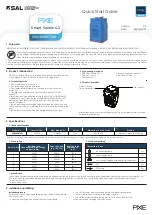
1-1
1
802.1X
Overview
The 802.1X protocol was proposed by the IEEE 802 LAN/WAN committee for security of wireless LANs
(WLAN).It has been widely used on Ethernet as a common port access control mechanism.
As a port-based access control protocol, 802.1X authenticates and controls accessing devices at the
port level. A device connected to an 802.1X-enabled port of an access control device can access the
resources on the LAN only after passing authentication.
Architecture of 802.1X
802.1X operates in the typical client/server model and defines three entities: Client, Device, and Server,
as shown in
Figure 1-1
.
Figure 1-1
Architecture of 802.1X
z
Client is an entity seeking access to the LAN. It resides at one end of a LAN segment and is
authenticated by Device at the other end of the LAN segment. Client is usually a user-end device
such as a PC. 802.1X authentication is triggered when an 802.1X-capable client program is
launched on Client. The client program must support Extensible Authentication Protocol over LAN
(EAPOL).
z
Device, residing at the other end of the LAN segment, authenticates connected clients. Device is
usually an 802.1X-enabled network device and provides access ports (physical or logical) for
clients to access the LAN.
z
Server is the entity that provides authentication services to Device. Server, normally running
RADIUS (Remote Authentication Dial-in User Service), serves to perform authentication,
authorization, and accounting services for users.
Authentication Modes of 802.1X
The 802.1X authentication system employs the Extensible Authentication Protocol (EAP) to exchange
authentication information between the client, device, and authentication server.
z
Between the client and the device, EAP protocol packets are encapsulated using EAPOL to be
transferred on the LAN.
Summary of Contents for 2928 - Baseline Plus Switch PWR
Page 92: ...1 9 Figure 1 7 Display the rate settings of ports ...
Page 105: ...1 4 Figure 1 3 Switch to the management level ...
Page 109: ...i Table of Contents 1 VCT 1 1 Overview 1 1 Testing Cable Status 1 1 ...
Page 114: ...1 2 Figure 1 2 Port traffic statistics ...
Page 279: ...1 28 Figure 1 26 The Port Setup tab ...
Page 331: ...i Table of Contents 1 Service Management 1 1 Overview 1 1 Configuring Service Management 1 2 ...
















































